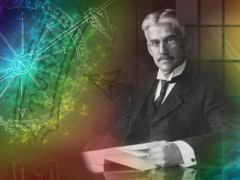
The Intersection of fine art and color science
Though Albert H. Munsell was an artist by trade, his passion for communicating color in an orderly fashion led to the development of early color communication devices. Munsell’s frustration with color chaos started him down the path of discovery.
As an educator, he was determined to bring order to the study of color. Munsell wanted the study of color to be similar to the study of music, which had order so that one could “hear” how a composition would sound by reading the notes. Likewise, Munsell wanted one to visualize color based on its three-dimensional attributes of hue, value and chroma. Munsell’s discovery of the three-dimensional aspect of color offered the order Munsell was looking for not only in terms of each individual color, but also each color’s relationship to other colors.
Little did Munsell know that his three-dimensional color theory would become the foundation of modern day color measurement and control systems, or did he have the vision for color science concepts and methods early on? In fact, Munsell, himself, developed a primitive color device as early as 1879, while a student at the Massachusetts Normal Art School (today’s Massachusetts College of Art and Design or “MassArt”) where he studied Rood’s Modern Chromatics. He created a twirling model by placing two pyramids base-to-base, painting the tops white and the bases black with the spectral colors surrounding the faces of the pyramids, which was likely the inspiration for his patented color sphere and mount and today’s color tree.
Pursuing the science of color
Albert Munsell continued his pursuit of the science of color by his association with scientists at Harvard and MIT through the turn of the century, some of whom included the grandfathers of color and optics such as Edward Charles Pickering (color index of stars). Then, as early as 1901, Munsell patented his photometer, an early predecessor to today’s photometers followed in 1902 by his Spinning Top. Now there’s an interesting application of Munsell’s Color Theory—spinning color disks to produce, as Munsell describes in the patent, “ethereal color or colored atmosphere, through which objects are visible.”
Munsell’s artistic and teaching perspectives combined with his passion for the scientific aspects of color—physiology, psychology and physics—contributed to the adoption of his ground breaking three-dimensional color theory. Royal B. Farnum, former director of the Rhode Island School of Design (RISDI) and 1906 graduate of Munsell’s alma mater, Massachusetts Normal Art School, describes Munsell best in his introduction to Munsell’s, A Color Notation, “The author, Albert H. Munsell, was an artist of distinction, a gifted teacher, and, withal, a man of unusual scientific proclivities.”
References:
Munsell color System, Company, and Foundation by Dorothy Nickerson (Reprinted from Color Research and Application, Volume 1, 1976 for The Munsell Color Foundation, Inc. 1977)
A Color Notation, A. H. Munsell, Munsell Color Company, Inc., 1971, pp. 6-7.



[…] Value and Chroma are the main qualities of color defined and organized with great mathematical precision by Munsell in the Color Space. Everything inside the space teaches you how to understand the […]